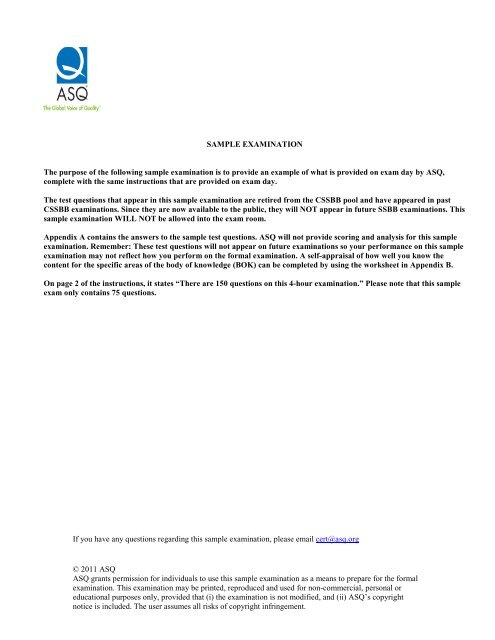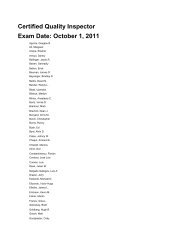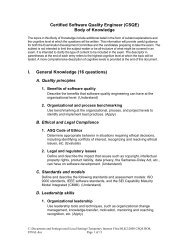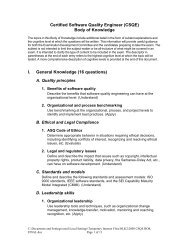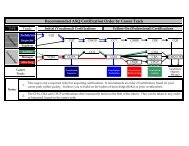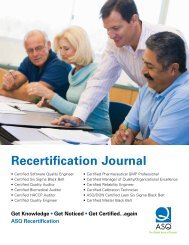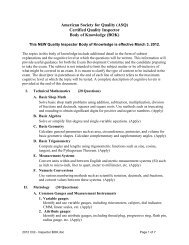05-2011 SSBB REV 2-col Sample Exam
05-2011 SSBB REV 2-col Sample Exam
05-2011 SSBB REV 2-col Sample Exam
Create successful ePaper yourself
Turn your PDF publications into a flip-book with our unique Google optimized e-Paper software.
SAMPLE EXAMINATION<br />
The purpose of the following sample examination is to provide an example of what is provided on exam day by ASQ,<br />
complete with the same instructions that are provided on exam day.<br />
The test questions that appear in this sample examination are retired from the C<strong>SSBB</strong> pool and have appeared in past<br />
C<strong>SSBB</strong> examinations. Since they are now available to the public, they will NOT appear in future <strong>SSBB</strong> examinations. This<br />
sample examination WILL NOT be allowed into the exam room.<br />
Appendix A contains the answers to the sample test questions. ASQ will not provide scoring and analysis for this sample<br />
examination. Remember: These test questions will not appear on future examinations so your performance on this sample<br />
examination may not reflect how you perform on the formal examination. A self-appraisal of how well you know the<br />
content for the specific areas of the body of knowledge (BOK) can be completed by using the worksheet in Appendix B.<br />
On page 2 of the instructions, it states “There are 150 questions on this 4-hour examination.” Please note that this sample<br />
exam only contains 75 questions.<br />
If you have any questions regarding this sample examination, please email cert@asq.org<br />
© <strong>2011</strong> ASQ<br />
ASQ grants permission for individuals to use this sample examination as a means to prepare for the formal<br />
examination. This examination may be printed, reproduced and used for non-commercial, personal or<br />
educational purposes only, provided that (i) the examination is not modified, and (ii) ASQ’s copyright<br />
notice is included. The user assumes all risks of copyright infringement.
THIS PAGE WAS LEFT BLANK INTENTIONALLY
NAME____________________________________<br />
CERTIFIED SIX SIGMA BLACK BELT<br />
Please print your name above. Read all the instructions before beginning the examination. If you are unsure about any part<br />
of the instructions, consult your proctor. In order for ASQ to be able to properly scan the Scantron answer sheet you must<br />
completely fill in the circle. Each circle must be filled in dark enough for the scanner to properly pick up the answer you<br />
chose. If not this could result in the exam not being scored correctly, or potentially delay your results.<br />
General Instructions<br />
All answers must be recorded on the Scantron Answer Sheet; no exam will be graded with the answers marked in the exam<br />
booklet.<br />
1. Using a soft lead pencil (#2 or softer) only, blacken the circle of the correct answer. Do not use ink. If you change your<br />
answer, be sure to erase the previous answer completely.<br />
2. Each question has ONE correct answer only.<br />
3. This is a timed test, so do not linger over difficult questions. Instead, skip the questions that you are unsure of and return<br />
to them if you have time when you reach the end of the test.<br />
4. Do not fold, staple, or tear the answer sheets.<br />
5. Although this is an open-book examination and personally generated materials/notes from training or refresher courses<br />
are allowed, the following conditions apply:<br />
• Each examinee must make his/her reference materials available to the proctor for review.<br />
• Absolutely no <strong>col</strong>lections of questions and answers or weekly refresher course quizzes are permitted. Reference<br />
sources that contain such copy are not allowed unless the questions and answers are removed or obscured.<br />
<strong>Exam</strong>ples of such sources include but are not limited to refresher and preparatory primers.<br />
• Calculator Policy: With the introduction of palmtop computers and the increasing sophistication of scientific<br />
calculators, ASQ has become aware of the need to limit the types of calculators that are permitted for use during the<br />
examinations. Any silent, hand-held, battery-operated calculator WITHOUT an alphabetic keyboard will be<br />
permitted. However all programmable memory must be cleared from the calculator before you enter the<br />
exam room. The examination is written so that a simple calculator will be sufficient to perform all calculations.<br />
• No laptop or palmtop computers are allowed.<br />
• Reference materials and calculators may not be shared.<br />
6. When you have finished, check your answer sheet to be sure it is properly identified with your name and member<br />
number. Return your examination booklet, answer sheet, and scratch paper to your proctor. You must sign the roster<br />
sheet to signify the return of your test booklet.<br />
7. It is strictly forbidden to copy or remove examination materials. You will be disqualified from the examination and not<br />
certified by ASQ if you breach this trust.<br />
8. TEST Results – you can check your test results 7 – 10 days after the exam date by logging into www.asq.org website and<br />
navigating to the Certification webpage. Otherwise, your exam results will be mailed in approximately two weeks.<br />
Please Be Patient we do not answer telephone requests for results
Special Instructions<br />
1. Please note that your answer sheet has been personalized with your name,<br />
member number, section number, and test type.<br />
2. Do NOT make any changes to these parts of the answer sheet. Doing so will<br />
only delay your exam results. Notify the Proctor of any changes.<br />
3. If you don’t have a personalized answer sheet, see your Proctor for further<br />
instructions.<br />
4. There are 150 questions on this 4-hour examination. Please check that you<br />
have the correct number of questions.<br />
STOP<br />
DO NOT CONTINUE UNTIL INSTRUCTED
C<strong>SSBB</strong>-SAMPLE EXAM<br />
CERTIFIED SIX SIGMA BLACK BELT Test<br />
Directions: Each of the questions or incomplete statements below is followed by four suggested answers or completions. Select the<br />
one that is best in each case and then fill in the corresponding space on the answer sheet.<br />
1. Which of the following tools should be used when a team<br />
is generating and prioritizing a list of options that include<br />
highly controversial issues<br />
(A) Brainstorming<br />
(B) Affinity diagrams<br />
(C) Nominal group technique<br />
(D) 5 whys<br />
2. The primary factor in the successful implementation of<br />
six sigma is to have<br />
(A) the necessary resources<br />
(B) the support and leadership of top management<br />
(C) explicit customer requirements<br />
(D) a comprehensive training program<br />
5. The most important aspect of functional requirements is<br />
that they<br />
(A) describe a single, measurable performance<br />
(B) describe how a product or service should operate<br />
(C) be traceable to the voice of the customer<br />
(D) provide upper and lower performance limits<br />
6. Which of the following control charts is most appropriate<br />
for monitoring the number of defects on different sample<br />
sizes<br />
(A) u<br />
(B) np<br />
(C) c<br />
(D) p<br />
3. Which of the following tools would be most appropriate<br />
for <strong>col</strong>lecting data to study the symptoms of a problem<br />
(A) Check sheet<br />
(B) Flow diagram<br />
(C) Force-field analysis<br />
(D) Activity network diagram<br />
7. Which of the following is most important in evaluating<br />
and understanding design intent<br />
(A) Identifying the functional requirement<br />
(B) Brainstorming failure modes<br />
(C) Conducting computer simulations<br />
(D) Developing FMEA<br />
4. Positional, cyclical, and temporal variations are most<br />
commonly analyzed in<br />
(A) SPC charts<br />
(B) multi-vari charts<br />
(C) cause and effect diagrams<br />
(D) run charts<br />
8. If a process follows an exponential distribution with a<br />
mean of 25, what is the standard deviation for the<br />
process<br />
(A) 0.4<br />
(B) 5.0<br />
(C) 12.5<br />
(D) 25.0<br />
3
C<strong>SSBB</strong>-SAMPLE EXAM<br />
9. Which of the following activities is value-added<br />
(A) Setup<br />
(B) Process<br />
(C) Storage<br />
(D) Inspection<br />
10. A black belt plans to test the performance of workers<br />
before and after training. Which of the following<br />
hypothesis tests should be used to determine whether the<br />
training actually improved the workers’ performance<br />
(A) 2-sample z test<br />
(B) 2-sample t test<br />
(C) Paired t test<br />
(D) F test<br />
11. The purpose of using control charts is to<br />
(A) determine if the process is performing within<br />
specifications<br />
(B) evaluate process performance over time<br />
(C) determine how to recreate the process<br />
(D) detect the causes of nonconformities<br />
12. Data being used in the initial set-up of a process are<br />
assumed to have a normal distribution. If the nominal<br />
(target) is set at the center of the distribution, and the<br />
specification limits are set at ±3σ from the center, then<br />
the C pk is equal to<br />
(A) –0.25<br />
(B) 1.00<br />
(C) 1.33<br />
(D) 1.67<br />
14. To assess the significance of factors in either a fractionalor<br />
a full-factorial experiment structure, a black belt can<br />
use<br />
(A) analysis of variance (ANOVA)<br />
(B) fault tree analysis (FTA)<br />
(C) failure mode and effects analysis (FMEA)<br />
(D) evolutionary operation (EVOP)<br />
15. Which of the following performance measures is most<br />
appropriate for evaluating the tangible effects of a six<br />
sigma project<br />
(A) Cycle time<br />
(B) Team member absentee rate<br />
(C) Employee morale<br />
(D) Unsolicited compliments from customers<br />
16. Which of the following is the best way to enhance the<br />
long-term availability of a machine<br />
(A) Machine repair<br />
(B) Total productive maintenance<br />
(C) Computerized SPC systems<br />
(D) Increased operator training<br />
17. Typically, which of the following activities is done<br />
earliest in the formation of a project team<br />
(A) Select the team<br />
(B) Identify the objective<br />
(C) Identify the sponsor<br />
(D) Allocate the resources<br />
13. Which of the following is defined as continuous,<br />
incremental improvement<br />
(A) Kanban<br />
(B) Kaizen<br />
(C) JIT<br />
(D) Kaikaku<br />
4
C<strong>SSBB</strong>-SAMPLE EXAM<br />
18. A black belt is developing a failure mode and effects<br />
analysis (FMEA) for the hamburger preparation station in<br />
a fast-food restaurant. The following ratings were<br />
developed for the low-heat temperature failure mode.<br />
Severity = 9<br />
Occurrence = 2<br />
Detection = 1<br />
What is the risk priority number (RPN) for this FMEA<br />
(A) 4<br />
(B) 6<br />
(C) 12<br />
(D) 18<br />
22. Poka-yoke is best defined as<br />
(A) improving machine efficiency<br />
(B) reducing field failures to virtually zero<br />
(C) capturing the voice of the customer<br />
(D) preventing controllable defects<br />
23. A measurement system analysis is designed to assess the<br />
statistical properties of<br />
(A) gage variation<br />
(B) process performance<br />
(C) process stability<br />
(D) engineering tolerances<br />
19. Which of the following statements is true about the<br />
theory of constraints<br />
(A) It views a system in terms of discrete processes.<br />
(B) Most constraints are physical.<br />
(C) Most constraints are the result of policies.<br />
(D) It focuses on continuous improvement.<br />
24. Which of the following best describes a controlled<br />
variable whose influence on a response is being studied<br />
(A) Replicate<br />
(B) Version<br />
(C) Level<br />
(D) Factor<br />
20. Which of the following describes the 95% confidence<br />
interval of a 20% absentee rate in a department with<br />
30 people<br />
(A) 6% to 34%<br />
(B) 8% to 32%<br />
(C) 13% to 27%<br />
(D) 17% to 23%<br />
21. A system that delivers products or services at the correct<br />
time and in the correct quantities is referred to as<br />
(A) takt time<br />
(B) kaizen<br />
(C) just-in-time<br />
(D) single-piece flow<br />
25. For a process, X = 35.0 and σ = 5.00. If the subgroup<br />
size is n = 5, what is the value for the upper control limit<br />
for the process<br />
(A) 37.24<br />
(B) 37.89<br />
(C) 41.71<br />
(D) 52.50<br />
26. Which of the following tools can be used to identify<br />
waste or non-value-added activities<br />
(A) Force field analysis<br />
(B) Pareto analysis<br />
(C) Scatter diagram<br />
(D) Process map<br />
5
C<strong>SSBB</strong>-SAMPLE EXAM<br />
27. A six sigma project to reduce billing statement expenses<br />
has shown the need to hire two additional mailroom<br />
clerks. Based on this information, which of the following<br />
metrics should be used to measure the financial benefits<br />
of the project<br />
(A) Cost of poor quality<br />
(B) Return on investment<br />
(C) Net present value<br />
(D) Internal rate of return<br />
28. A tree diagram can be used to do which of the following<br />
(A) Allow a team to identify root causes even when no<br />
credible data exist<br />
(B) Show a causality relationship<br />
(C) Present data from a check sheet<br />
(D) Reveal the true level of a problem’s complexity<br />
29. Which of the following terms is used to describe the risk<br />
of a type I error in a hypothesis test<br />
(A) Power<br />
(B) Confidence level<br />
(C) Level of significance<br />
(D) Beta risk<br />
30. Which of the following is a component of a visual<br />
factory<br />
(A) Product specifications<br />
(B) Zero defect policies<br />
(C) Just-in-time policies<br />
(D) Equipment service manuals<br />
31. When σ = 10, what sample size is needed to specify a<br />
95% confidence interval of ±3 units from the mean<br />
32. A company has installed a system that prevents orders<br />
with incorrect information from being forwarded to<br />
production scheduling. This is an example of which of<br />
the following lean tools<br />
(A) Standard work<br />
(B) Kanban<br />
(C) Poka-yoke<br />
(D) Visual factory<br />
33. After the major headings of a tree diagram have been<br />
broken into greater detail, what is the next step that<br />
should be taken<br />
(A) Assemble the right team<br />
(B) Review the diagram for logical flow and<br />
completeness<br />
(C) Revise the problem statement<br />
(D) Choose the tree diagram goal statement<br />
34. A six sigma team has been formed to improve an existing<br />
process. Which of the following tools should the team use<br />
first to gain a clear understanding of the current process<br />
(A) Flowchart<br />
(B) Pareto chart<br />
(C) Process FMEA<br />
(D) Latin square DOE<br />
35. Which of the following techniques dramatically shortens<br />
changeover times<br />
(A) Continuous flow<br />
(B) Standard work<br />
(C) Work in process (WIP)<br />
(D) Single minute exchange of dies (SMED)<br />
(A) 7<br />
(B) 11<br />
(C) 32<br />
(D) 43<br />
6
C<strong>SSBB</strong>-SAMPLE EXAM<br />
36. Correction, over-production, inventory, and motion are<br />
all examples of<br />
(A) waste<br />
(B) 5S target areas<br />
(C) noise<br />
(D) value-added activities<br />
41. The primary reason that most companies implement six<br />
sigma is to<br />
(A) reduce defects<br />
(B) improve processes<br />
(C) improve profit<br />
(D) increase customer satisfaction<br />
37. A store uses signs at specific points in its storage area to<br />
indicate when products need to be ordered. This practice<br />
is an example of<br />
(A) kanban<br />
(B) poka-yoke<br />
(C) checkpoints<br />
(D) hoshin<br />
38. A method that changes data without significantly<br />
reducing accuracy or precision is known as<br />
(A) bias adjustment<br />
(B) statistical efficiency<br />
(C) blocking<br />
(D) coding<br />
39. A company’s accounts payable department is trying to<br />
reduce the time between receipt and payment of invoices.<br />
If the team has just completed a flowchart of the process<br />
and identified the critical steps, which of the following<br />
tools should be used next<br />
(A) Fishbone diagram<br />
(B) Scatter diagram<br />
(C) Box and whisker plot<br />
(D) Histogram<br />
40. When a team consists of five black belts and eight quality<br />
engineers, how many unique meetings could be held<br />
consisting of one black belt and two quality engineers<br />
42. For consumer products, an increase in the percentage of<br />
returned goods most likely equates to an increase in<br />
(A) product not meeting specifications<br />
(B) end-user dissatisfaction<br />
(C) internal reject rates<br />
(D) nonconforming material costs<br />
43. Legal requirements specify that a bottled product must<br />
contain at least the volume printed on the label. A<br />
bottling company wants to reduce the amount of<br />
overfilled bottles.<br />
Frequency<br />
LSL<br />
Fill weight<br />
On the basis of the data above, what is the most effective<br />
strategy to accomplish this task<br />
(A) Decrease the target fill volume only<br />
(B) Decrease the target fill variation only<br />
(C) First decrease the target fill volume, then decrease the<br />
target fill variation<br />
(D) First decrease the target fill variation, then decrease<br />
the target fill volume<br />
(A) 40<br />
(B) 80<br />
(C) 140<br />
(D) 280<br />
7
C<strong>SSBB</strong>-SAMPLE EXAM<br />
44. In measurement system analysis, which of the following<br />
pairs of data measures is used to determine total<br />
variance<br />
(A) Process variance and reproducibility<br />
(B) Noise system and repeatability<br />
(C) Measurement variance and process variance<br />
(D) System variance and bias<br />
45. If the number of runs required for a full-factorial<br />
experiment is cost-prohibitive, which of the following<br />
experiments would have the same number of variables<br />
but fewer runs<br />
(A) Completely randomized factorial<br />
(B) Replicated factorial<br />
(C) Multilevel factorial<br />
(D) Fractional factorial<br />
46. A six sigma team has been chartered to improve the way<br />
in which a company takes orders for its products. Which<br />
of the following tools should the team use to determine<br />
all of the potential pitfalls and the actual defects that<br />
occur<br />
(A) Process failure mode and effects analysis<br />
(B) Process map<br />
(C) Design for six sigma<br />
(D) Supplier input process output control<br />
47. According to Juran, anyone is a customer of a product or<br />
service if that person<br />
(A) purchases it<br />
(B) uses it<br />
(C) is affected by it<br />
(D) produces it<br />
48. In regression analysis, which of the following techniques<br />
can be used to reduce the higher-order terms in the model<br />
49. Which of the following is the correct formula for DPMO<br />
(A) D/TOP<br />
(B) DPO× 1,000,000<br />
(C) D× U× OP<br />
(D) DPU/DPO<br />
50. Which of the following will have the most influence on<br />
consumers’ perception of quality<br />
(A) Industry standards<br />
(B) Company financial performance<br />
(C) Audit results<br />
(D) Service and repair policies<br />
51. “Forming, Storming, Norming, and Performing” are<br />
terms that describe<br />
(A) process variation reduction and improvement phases<br />
(B) root cause identification and corrective action<br />
(C) stages of team growth<br />
(D) steps of the brainstorming process<br />
52. The following contingency table was developed for an<br />
organization.<br />
Station 1 Station 2 Station 3 Total<br />
Oil changes 100 36 92 228<br />
Tire rotations 50 35 102 187<br />
Tune-ups 60 40 85 185<br />
Total 210 111 279 600<br />
On the basis of this information, what is the expected<br />
number of oil changes for Station 1 <br />
(A) 70<br />
(B) 76<br />
(C) 80<br />
(D) 100<br />
(A) Large samples<br />
(B) Dummy variables<br />
(C) Transformations<br />
(D) Blocking<br />
8
C<strong>SSBB</strong>-SAMPLE EXAM<br />
53. A change agent is responsible for helping the<br />
organization do which of the following<br />
(A) Overcome fear of the unknown<br />
(B) Reorganize departments<br />
(C) Determine performance criteria<br />
(D) Identify which group is responsible for failures<br />
58. Which of the following charts plots the mean of a set of<br />
values and recalculates the mean with each new value<br />
(A) Moving range<br />
(B) Moving average<br />
(C) X and s<br />
(D) c<br />
54. The process of having a six sigma team develop a<br />
problem statement helps the team<br />
(A) agree on key dates associated with completing major<br />
project phases<br />
(B) achieve consensus and ownership of the process<br />
(C) determine solutions<br />
(D) determine how often it should meet<br />
55. Which of the following is an element of standard work<br />
(A) Takt time<br />
(B) Product cost<br />
(C) Product value<br />
(D) Maximum inventory<br />
59. Which of the following tools is appropriate to use with<br />
multiple criteria requiring a single option to be selected<br />
(A) Pugh matrix<br />
(B) Kano model<br />
(C) Hypothesis testing<br />
(D) PDCA<br />
60. In order for a problem to be solved correctly, which of<br />
the following must occur first<br />
(A) The problem must be defined.<br />
(B) Relevant data must be gathered.<br />
(C) The measurement system must be validated.<br />
(D) The process must be mapped.<br />
56. An important aspect of data <strong>col</strong>lection is that the data<br />
<strong>col</strong>lector should<br />
(A) determine the dispersion of the data<br />
(B) know how the data are to be used<br />
(C) use a control chart to analyze the data<br />
(D) use a stratified sampling plan<br />
61. In comparison to a full-factorial design of experiment<br />
(DOE), a traditional, one-at-a-time approach will<br />
(A) miss interactions<br />
(B) gain efficiencies<br />
(C) save time<br />
(D) cost less<br />
57. A process produces nonconformities according to a<br />
Poisson distribution. If the mean of the nonconformities<br />
is 25, what is the standard deviation<br />
(A) 2.5<br />
(B) 5.0<br />
(C) 12.5<br />
(D) 25.0<br />
62. Which of the following tools is used extensively in<br />
quality function deployment (QFD)<br />
(A) Affinity diagram<br />
(B) Matrix diagram<br />
(C) Cause and effect diagram<br />
(D) Activity network diagram<br />
9
C<strong>SSBB</strong>-SAMPLE EXAM<br />
63. A six sigma team has gathered data for a project proposal<br />
and is using the following notations.<br />
I = Initial investment<br />
C = Periodic maintenance cost<br />
B = Benefits to be accrued<br />
On the basis of the information above, which of the<br />
following is the criteria used to select a project<br />
B<br />
(A) > 0<br />
I + C<br />
B<br />
(B) > 1<br />
I + C<br />
B<br />
(C) ≤ 1<br />
I + C<br />
B<br />
(D) ≤ 0<br />
I + C<br />
64. Which of the following best describes a team that has<br />
members with different skills or roles from different areas<br />
within the organization<br />
(A) Self-directed<br />
(B) Cross-functional<br />
(C) Parallel<br />
(D) Process<br />
65. The time for a fail-safe device to trip is thought to be a<br />
discrete uniform distribution from 1 to 5 seconds. To test<br />
this hypothesis, 100 tests are conducted with results as<br />
shown below.<br />
Trip time<br />
seconds ( j )<br />
Actual<br />
(O j )<br />
Theoretical<br />
(E j )<br />
( 0<br />
j<br />
− E<br />
j<br />
)<br />
1 10 20 100<br />
2 15 20 25<br />
3 50 20 900<br />
4 15 20 25<br />
5 10 20 100<br />
100 100 χ 2 =<br />
df =<br />
On the basis of these data, what are the chi square (χ 2 )<br />
value and the number of degrees of freedom (df)<br />
χ 2<br />
df<br />
(A) 57.5 4<br />
(B) 57.5 5<br />
(C) 1,150.0 4<br />
(D) 1,150.0 5<br />
66. Which of the following methods is used to develop an<br />
exhaustive list of ideas about a subject<br />
(A) Benchmarking<br />
(B) Brainstorming<br />
(C) Goal-setting<br />
(D) Problem-solving<br />
2<br />
67. Which of the following techniques would help increase<br />
process stability when the cause of variation is a cluttered<br />
work station<br />
(A) 5S<br />
(B) SMED<br />
(C) Preventive maintenance<br />
(D) Visual factory<br />
10
C<strong>SSBB</strong>-SAMPLE EXAM<br />
68. Benchmarking is difficult to perform on processes that<br />
(A) can be identified and researched easily<br />
(B) are practiced in many different industries<br />
(C) have a major impact on the success of the business<br />
(D) have not been documented<br />
69. Which of the following tools is commonly used in the<br />
define phase of a project<br />
(A) Affinity diagram<br />
(B) Control chart<br />
(C) Failure mode and effects analysis<br />
(D) Data <strong>col</strong>lection checklist<br />
70. One characteristic of attributes data is that it is always<br />
(A) continuous<br />
(B) discrete<br />
(C) expensive to <strong>col</strong>lect<br />
(D) read from a scale of measurement<br />
71. Which of the following best describes internal failure<br />
costs<br />
(A) The economic costs associated with a catastrophic<br />
failure of an internal subsystem.<br />
(B) The unavoidable quality system costs associated with<br />
the production of any product or service.<br />
(C) The opposite of external failure costs.<br />
(D) The costs resulting from a nonconformance detected<br />
before a product or service is provided.<br />
72. According to Juran, when a major quality improvement<br />
project is launched, which of the following describes the<br />
desired change in performance level<br />
(A) Six sigma<br />
(B) Continuous<br />
(C) Breakthrough<br />
(D) Sporadic<br />
73. Which of the following is an important responsibility of a<br />
project champion<br />
(A) Leading the team<br />
(B) Documenting the overall progress of the team<br />
(C) Allocating resources to support the team<br />
(D) Coaching the team on the DMAIC process<br />
74. A black belt would use non-parametric statistical<br />
methods when<br />
(A) knowledge of the underlying distribution of the<br />
population is limited<br />
(B) the measurement scale is either nominal or ordinal<br />
(C) the statistical estimation is required to have higher<br />
assurance<br />
(D) management requires substantial statistical analysis<br />
prior to implementing<br />
75. For a normal distribution, two standard deviations on<br />
each side of the mean would include what percentage of<br />
the total population<br />
(A) 47%<br />
(B) 68%<br />
(C) 95%<br />
(D) 99%<br />
STOP.<br />
IF YOU FINISH BEFORE TIME IS CALLED, YOU MAY GO BACK AND CHECK YOUR WORK ON THIS TEST.<br />
11
C<strong>SSBB</strong>-SAMPLE EXAM<br />
APPENDIX A: Answer Sheet<br />
For each sample test question, the correct answer is provided below along with the area of the body of knowledge (BOK) that the item<br />
is classified to. This sample examination is not intended to represent all areas of the BOK but to provide a sampling from each major<br />
topic area. All ASQ examinations are based on the BOK for that particular exam. To view the BOK for C<strong>SSBB</strong>, please go to<br />
http://www.asq.org/certification/six-sigma/bok-07.html<br />
Question BOK Correct Answer<br />
1 III.E. C<br />
2 I.B.1 B<br />
3 V.B.4 A<br />
4 VI.A.4 B<br />
5 IV.A.3 C<br />
6 VIII.A.4 A<br />
7 IV.A.3 A<br />
8 V.E.3 D<br />
9 VII.B. B<br />
10 VI.B.5 C<br />
11 VIII.A.1 B<br />
12 V.F.1 B<br />
13 VII.D. B<br />
14 VII.A.6 A<br />
15 V.A.2 A<br />
16 VIII.B.1 B<br />
17 III.A.4 B<br />
18 VI.C. D<br />
19 VII.E. C<br />
20 VI.B.4 A<br />
21 VI.D.3 C<br />
22 VII.B. D<br />
23 VIII.C.1 A<br />
24 VII.A.1 D<br />
25 VIII.A.4 C<br />
26 V.A.2 D<br />
27 II.E. B<br />
28 III.F. D<br />
29 VI.B.1 C<br />
30 VIII.B.2 A<br />
31 VI.B.4 D<br />
32 VII.B.5 C<br />
33 III.F. B<br />
34 V.A.3 A<br />
35 VII.C. D<br />
36 VI.D.3 A<br />
37 VII.B. A<br />
38 V.B.4 D<br />
Question BOK Correct Answer<br />
39 VI.D.2 A<br />
40 V.E.1 C<br />
41 I.A.2 C<br />
42 IV.A.2 B<br />
43 V.D.4 D<br />
44 V.C.2 C<br />
45 VII.A.5 D<br />
46 VI.C. A<br />
47 IV.A.1 C<br />
48 VI.A.2 C<br />
49 V.F.7 B<br />
50 IV.A.2 D<br />
51 III.B.2 C<br />
52 VI.B.8 C<br />
53 I.B.3 A<br />
54 III.A.4 B<br />
55 VII.B. A<br />
56 V.B.4 B<br />
57 V.E.2 B<br />
58 VIII.A.4 B<br />
59 IX.D.2 A<br />
60 IV.B.1 A<br />
61 VII.A.3 A<br />
62 III.F. B<br />
63 IV.B.4 B<br />
64 III.A.1 C<br />
65 VI.B.7 A<br />
66 III.E. B<br />
67 VII.B. A<br />
68 II.C. D<br />
69 III.F. A<br />
70 V.B.1 B<br />
71 II.E. D<br />
72 I.A.1 C<br />
73 I.B.5 C<br />
74 VI.B.9 A<br />
75 V.E.2 C<br />
12
C<strong>SSBB</strong>-SAMPLE EXAM<br />
APPENDIX B: Analyzing Body of Knowledge (BOK) Content<br />
The following worksheet can be used to help you analyze the results of your answers on this sample examination. It can be used to<br />
determine which areas of the body of knowledge (BOK) you may want to study.<br />
After learning which sample test questions you had correct, total the number you had correct and enter that number into the 2 nd <strong>col</strong>umn<br />
of the worksheet. The 3 rd <strong>col</strong>umn provides the total number of test questions that are in this sample examination for that major area of<br />
the BOK. The last <strong>col</strong>umn provides the total number of test questions that appear in a formal ASQ examination for that area of the<br />
BOK.<br />
<strong>2011</strong> BOK Topic Area<br />
I. Enterprise-wide Deployment<br />
II. Organizational Process<br />
Management and Measures<br />
III. Team Management<br />
IV. Define<br />
V. Measure<br />
VI. Analyze<br />
Total You<br />
Had Correct<br />
on <strong>Sample</strong><br />
<strong>Exam</strong><br />
Total in the<br />
<strong>Sample</strong><br />
<strong>Exam</strong><br />
Total in<br />
Formal ASQ<br />
<strong>Exam</strong><br />
5 9<br />
3 9<br />
10 16<br />
7 15<br />
15 26<br />
14 24<br />
VII. Improve 13 23<br />
VIII. Control 7 21<br />
IX. Design for Six Sigma<br />
1 7<br />
(DFSS) Frameworks and<br />
Methodologies<br />
GRAND TOTAL 75 150<br />
13


